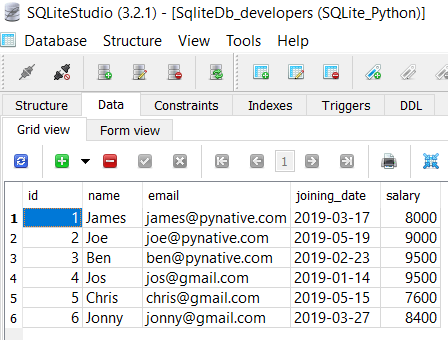This article demonstrates the use of Python’s cursor class methods fetchall(), fetchmany(), and fetchone() to retrieve rows from a database table. This article applies to all the relational databases, for example, SQLite, MySQL, PostgreSQL.
Also Read:
Python Database API Specification v2.0 (PEP 249) has been designed to encourage and maintain similarity between the Python modules used to access databases. So it doesn’t matter which database you use. Be it MySQL, PostgreSQL, and SQLite syntax, the syntax of functions and how to access the relational database are the same in all database modules.
We generally use the following Python module to work with Databases.
| Database | Module |
|---|---|
| MySQL | MySQL Connector Python |
| PostgreSQL | Psycopg2 |
| SQLite | sqlite3 |
Above all modules adhere to Python Database API Specification v2.0 (PEP 249).
This lesson will show how to use fetchall(), fetchmany(), and fetchone() to retrieve data from MySQL, PostgreSQL, SQLite database.
First understand what is the use of fetchall, fetchmany(), fetchone().
cursor.fetchall() fetches all the rows of a query result. It returns all the rows as a list of tuples. An empty list is returned if there is no record to fetch.
cursor.fetchmany(size) returns the number of rows specified by size argument. When called repeatedly, this method fetches the next set of rows of a query result and returns a list of tuples. If no more rows are available, it returns an empty list.
cursor.fetchone() method returns a single record or None if no more rows are available.
I have created a database_developers table in my database. Now, it contains five rows. let see how to use fetchall to fetch all the records.
Let see the examples now.

Table of contents
Fetch all rows from database table using cursor’s fetchall()
Now, let see how to use fetchall to fetch all the records. To fetch all rows from a database table, you need to follow these simple steps: –
- Create a database Connection from Python. Refer Python SQLite connection, Python MySQL connection, Python PostgreSQL connection.
- Define the SELECT query. Here you need to know the table and its column details.
- Execute the SELECT query using the
cursor.execute()method. - Get resultSet (all rows) from the cursor object using a
cursor.fetchall(). - Iterate over the ResultSet using
forloop and get column values of each row. - Close the Python database connection.
- Catch any SQL exceptions that may come up during the process.
Let try to fetch all rows from the table.
Output:
Connected to database Total rows are: 5 Printing each row Id: 1 Name: Emma Email: emma@pynative.com Salary: 12000.0 Id: 2 Name: Scott Email: scott@pynative.com Salary: 22000.0 Id: 3 Name: Jessa Email: jessa@pynative.com Salary: 18000.0 Id: 4 Name: Mike Email: mike@pynative.com Salary: 13000.0 Id: 5 Name: Ricky Email: ricky@pynative.com Salary: 19000.0 The Sqlite connection is closed
Also read:
Retrieve a few rows from a table using cursor.fetchmany(size)
One thing I like about Python DB API is the flexibility. In the real world, fetching all the rows at once may not be feasible. So Python DB API solves this problem by providing different versions of the fetch function of the Cursor class. The most commonly used version is the cursor.fetchmany(size).
The syntax of the cursor’s fetchmany()
rows = cursor.fetchmany([size=cursor.arraysize])Code language: Python (python)- Here size is the number of rows to be retrieved. This method fetches the next set of rows of a query result and returns a list of tuples. If no more rows are available, it returns an empty list.
- Cursor’s
fetchmany()method returns the number of rows specified by size argument. the default value is 1. If the specified size is 100, then it returns 100 rows.
Let try to fetch 3 rows from table using a cursor.fetchmany(size)
Output:
Connected to database Fetching Total 3 rows Printing each row Id: 1 Name: Emma Email: emma@pynative.com Salary: 12000.0 Id: 2 Name: Scott Email: scott@pynative.com Salary: 22000.0 Id: 3 Name: Jessa Email: jessa@pynative.com Salary: 18000.0 The Sqlite connection is closed
Also read:
Note:
fetchmany()returns an empty list when no more rows are available in the table.- A
ProgrammingErrorraised if the previous call toexecute*()did not produce any result set or no call issued yet. fetchmany()returns fewer rows if the table contains the fewer number of rows specified by theSIZEargument.
What will happen if the cursor’s fetchmany(size) called repeatedly
What will happen if we called cursor.fetchmany(size) repeatedly after executing a SQL query.
For example, we ran a query, and it returned a query result of 10 rows. Next, we fetched the first two rows using cursor.fetchmany(2). Again, we called the cursor.fetchmany(2), then it will return the next two rows. Let see the example to understand it better.
Output:
Connected to database Fetching Total 2 rows Printing each row Id: 1 Name: Emma Email: emma@pynative.com Salary: 12000.0 Id: 2 Name: Scott Email: scott@pynative.com Salary: 22000.0 Fetching next 2 rows from a table Printing each row Id: 3 Name: Jessa Email: jessa@pynative.com Salary: 18000.0 Id: 4 Name: Mike Email: mike@pynative.com Salary: 13000.0 The Sqlite connection is closed
Retrieve a single row from a table using cursor.fetchone
- Python DB API allows us to fetch only a single row. To fetch a single row from a result set we can use
cursor.fetchone(). This method returns a single tuple. - It can return a none if no rows are available in the resultset.
cursor.fetchone()increments the cursor position by one and return the next row.
Let see the example now.
Output:
Connected to database Fetching single row (1, 'Emma', 'emma@pynative.com', 12000.0) Fetching next row (2, 'Scott', 'scott@pynative.com', 22000.0) The Sqlite connection is closed
Next Steps:
To practice what you learned in this article, Solve a Python SQLite Exercise project to practice database operations.
